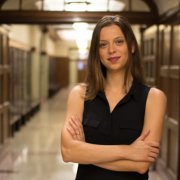Laser Microscopes Seeing the Unseen
The Calhoun Lab uses short laser pulses to take pictures of the unseen, so they can show how molecules behave, and how we can optimize their performance. Most research microscopes make use of fluorescence to create images; some molecules will glow and others will not. Nonlinear microscopy uses femtosecond (a millionth of a billionth of a second) laser pulses to map molecules and phenomena that can’t be seen using fluorescence.
“When you work with light like that, all sorts of things you don’t encounter in the normal world can happen,” said Dr. Tessa Calhoun of the University of Tennessee, Knoxville.
While a lot of time in the Calhoun Lab is spent developing custom instruments used to perform the experiments, the group is an interdisciplinary team that applies these capabilities to the study of biological systems. The Calhoun Lab is analyzing the behavior of antibiotics by incubating the small molecule drugs with bacterial and fungal cells and taking images of the resulting interactions. One antibiotic under investigation has been clinically used for over 50 years with limited clinical resistance. To be able to see the path of delivery for the drug, and other ways it interacts with the cell membrane, with nonlinear microscopy would allow other, more effective antibiotics to be developed.
The images can show researchers information about the interplay between the drug molecules and the living cells that defy previous theories about the way individual antibiotics work. Not only will the lab be able to see how the drugs are delivered, they will be able to create guidelines on how to manipulate future antibiotics in ways that weren’t conceivable before. For example, understanding the environment surrounding drug molecules will allow for more control over their efficacy.
The future of this research includes:
-
Nonlinear microscopy of small molecule drugs interacting with biological membranes: Using many different techniques including transient absorption, second harmonic generation, and sum frequency generation microscopies, the Calhoun Lab is directly visualizing where small molecule antibiotics go when they encounter membranes in both model systems and living cells. These advanced and complementary capabilities also allow them to extract new information from these systems to better explain the drugs' behavior.
-
Surface studies of nanoparticles: Great effort has been, and continues to be, invested into the modification of nanoparticle surfaces to alter their properties for a wide range of applications. The Calhoun Lab is applying nonlinear techniques to directly measure how the energetics of these surfaces are impacted by different conditions.
The Calhoun Lab, led by Dr. Tessa Calhoun of the University of Tennessee, Knoxville, uses advanced ultrafast laser microscopes to investigate a wide range of scientific questions such as: “Where does a drug molecule go when it interacts with a living cell?” and “How do the surfaces of materials interact with incident light?” The Calhoun Lab is problem solving on a day-to-day basis, optimizing methods to extract the answers to these questions using advanced optical microscopy techniques.
Bio
Tessa Calhoun is the Assistant Professor of Chemistry at the University of Tennessee, Knoxville. Her path is chemistry research started early where she was amazed by the experience of building a molecule step-by-step during a high school summer research program. After being introduced to her first ultrafast laser as an undergraduate student, she never looked back. Calhoun’s graduate work was her first exposure to research on biological systems and has made her come to appreciate Nature’s capabilities and specifically how little we understand them, how complex they are, and how simplistic they make our own efforts appear.

